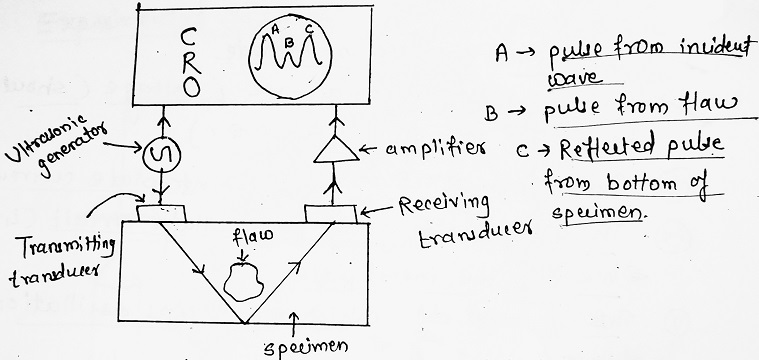Applications of Ultrasonic Waves:
(1) Detection of Flaws in Metals: The strength of components plays an important role in most engineering applications. The strength of the material is reduced due to the presence of any kind of defect in it. The defects can be as large as cracks or as tiny as cavities. The method of detection of such flaws in metals (or also in plastic) using ultrasonic is more reliable, convenient and cheap than using X-rays or γ-rays.
An instrument used to detect the defects such as cracks, flaws and holes in metals is called an ultrasonic inspectascope.
- When ultrasonic waves pass through metal having some hole or crack inside it, an appreciable reflection occurs.
- Ultrasound is also reflected from the back surface of the crystal.
- The reflected pulses are picked up by the receiver and are suitably amplified, and these pulses are now applied to CRO.
- The transmitted signal and reflected signal from flaw and back surface of metal produce a peak each.
- The position of the time base of the oscilloscope for the 2nd peak will give the distance of flaw.

The experimental arrangement is shown in the figure above. Here the transmitting transducer sends a beam of ultrasonics through the material under test. In the presence of a flaw in the specimen, the intensity of the signal reflected back in the receiver will be very weak. Similarly, for a specimen having no flaw, the corresponding signal will be strong. Thus the presence of a small peak on the screen implies the presence of a flaw in the material.
(2) Echo Sounding or Echo Signalling: Ultrasonic waves are highly energetic and due to smaller wavelengths are highly directional and thus show less diffraction. Due to this, ultrasonic waves are not absorbed by water so strongly as low-frequency waves. This property is useful in echo sounding as follows-
(i) Depth Signalling- Ultrasonic waves can be used to determine the depth of sea or depth of water below the ship. Ultrasonic waves are produced and are directed towards the bottom of the sea, at regular intervals. The reflected waves from the bottom of the sea are received. The time interval between sending and reflected waves is recorded.
If ν is the known velocity of ultrasonic waves, the depth of sea = velocity x time/2
(ii) Sound Signalling- This technique is useful in giving the signal to a distant ship. Here high frequency ultrasonic waves are used.
(iii) SONAR- (Detection of icebergs, submarines and other objects in the sea).
SONAR is a device which stands for Sound Navigation and Ranging. Using SONAR it is possible to determine the presence of submerged submarines or an enemy aircraft.
In this system, a sharp U-beam is directed in various directions into the sea. These are picked up on their return after reflection. The reflection of waves represents the presence of some reflecting body in the sea. By know the time interval, the distance of the body can also be calculated. Also, the change in frequency of echo-signal (due to the Doppler effect) helps to determine the velocity and direction of the body.
(3) Cleaning and Clearing- Ultrasonic waves can be used for cleaning utensils, washing clothes and removing dust and soot from the chimney.
(4) Soldering and Metal Cutting- Ultrasonic waves can be used for drilling and cutting processes in metals. These waves can also be used in soldering (for example- soldering of aluminium, which can not be done by normal methods).
(5) Ultrasonic Mixing- A mixture of two non-mixible liquids i.e. a colloid solution (for example- oil and water) can be formed by simultaneously subjecting to ultrasonic radiations. For example- colloid solutions produced using ultrasonic mixing are polishes, paints, food products and pharmaceutical products etc.
(6) Destruction of Lower Life- Animals like rats, frogs, fishes etc. can be killed or injured by high-intensity ultrasonics.
(7) Medical Field-
(i) Diagnosis- Ultrasonic waves are safer than X-rays and are used in the detection of certain tumours.
(ii) Treatment of Neuralgic Pain- The body parts affected due to neuralgic or rheumatic pains get great relief from pain if exposed to Ultrasonic waves.
(iii) Dental Treatment- Ultrasonic waves are highly advantageous in dental treatment because they make dental cutting almost painless, and cut hard material easily, any other mechanical device is not required for cutting.
(iv) Used in Ultrasonography (to observe child growth in mother’s womb) and hence making it useful for diagnosis and treatment.









Comments (No)